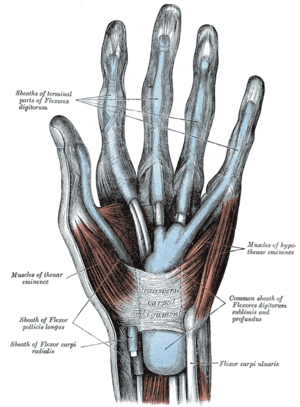 Image via Wikipedia
Image via Wikipedia
Check out this illustration of the hand. Note the common sheath for the tendons, especially how it runs down the carpal tunnel. Its the big fat structure in light blue.
As we've seen throughout the body, sheaths have been known to stiffen when they are not stretched regularly.
Could this sheath become stiff enough to cause the pressure on the nerve that characterizes carpal tunnel syndrome?
If so, manipulating this sheath may release the pressure on the carpal nerve.
Its also conceivable that stiffness in the forearm could be interfering with the normal positioning of this nerve. So, the wrist is flexed, the range of motion available to this nerve is reduced, resulting in the pain.
A complex problem with many factors. One thing is for sure. Slicing the ligament is not the last word in treating this painful condition.




